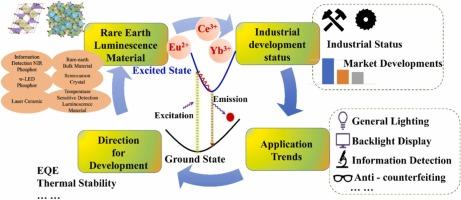稀土发光材料的发展现状
IF 6.3
2区 材料科学
Q2 CHEMISTRY, PHYSICAL
引用次数: 0
摘要
稀土发光材料在普通照明、背光显示应用、信息检测、光电器件、现代农业、光存储、防伪等领域得到了广泛关注和迅速发展,是稀土材料科学研究的一个重要方向。稀土发光材料包括多种类型,分为几个关键类型:(1)高性能荧光粉,包括Eu2+/Ce3+活化氮化物和氧氮化物,用于全光谱应用,如Y3Al5O12: Ce3+和Sr2Si5N8: Eu2+照明,以及宽色域液晶显示(LCD)背光,如β-SiAlON: Eu2+绿色荧光粉和K2SiF6: Mn4+红色荧光粉;(2) Cr3+掺杂的石榴石和没食子酸盐,作为磷光转换led (pc- led)的主要近红外(NIR)荧光粉,在750 - 1100nm范围内发光,全宽度在半宽(FWHM)和100 nm;(3)用于光学传感的Er3+/Yb3+上转换系统;(4)辐射检测用Eu3+/Tb3+体发光材料;(5)掺杂Ln3+ (Ln = Dy, Eu)的持久性荧光粉和镧系配合物防伪油墨。本文重点介绍了稀土发光材料的机理研究进展,以及稀土发光材料的技术和工业发展现状。重点分析了全光谱照明荧光粉、宽色域LCD背光荧光粉、pc-LED近红外发光荧光粉、上转换发光材料、体发光材料、温敏检测发光材料、持久发光(PersL)材料、防伪材料、稀土发光材料的产业发展等关键类别。此外,还讨论了该领域的潜在挑战和未来趋势。未来的发展路径将集中在缺陷工程、新基质的发现和可持续制造上,以克服现有的障碍。本文章由计算机程序翻译,如有差异,请以英文原文为准。

Development Status of Rare Earth Luminescence Material
Rare earth luminescence materials which have garnered significant attention and advanced rapidly in fields such as general lighting, backlight display applications, information detection, photoelectric devices, modern agriculture, optical storage, and anti-counterfeiting, represent a crucial research direction within rare earth materials science. Rare earth luminescence materials encompass a diverse range, categorized into several key types: (1) High-performance phosphors, including Eu2+/Ce3+-activated nitrides and oxynitrides for full-spectrum applications—such as Y3Al5O12: Ce3+ and Sr2Si5N8: Eu2+ for lighting, and wide-gamut liquid crystal display (LCD) backlights, exemplified by β-SiAlON: Eu2+ green phosphors and K2SiF6: Mn4+ red phosphors; (2) Cr3+-doped garnets and gallates, which serve as leading near-infrared (NIR) phosphors for phosphor-converted LEDs (pc-LEDs), emitting in the 750–1100 nm range with a full width at half maximum (FWHM) <100 nm; (3) Er3+/Yb3+ up-conversion systems for optical sensing; (4) Eu3+/Tb3+ bulk luminescence materials for radiation detection; and (5) Ln3+-doped (Ln = Dy, Eu) persistent phosphors and lanthanide-complex anti-counterfeiting inks. This article highlights advancements in mechanistic investigations, as well as the current status of technical and industrial development in rare earth luminescence materials. Special focus is placed on analyzing key categories: full-spectrum lighting phosphors, wide color gamut LCD backlight phosphors, pc-LED phosphors for NIR emission, up-conversion luminescence materials, bulk luminescence materials, temperature-sensitive detection luminescence materials, Persistent luminescence (PersL) materials, anti-counterfeiting materials, and the industrial development of rare earth luminescence materials. Additionally, potential challenges and future trends in this field are discussed. Future development pathways will center on defect engineering, the discovery of novel host matrices, and sustainable manufacturing to overcome existing barriers.
求助全文
通过发布文献求助,成功后即可免费获取论文全文。
去求助
来源期刊

Journal of Alloys and Compounds
工程技术-材料科学:综合
CiteScore
11.10
自引率
14.50%
发文量
5146
审稿时长
67 days
期刊介绍:
The Journal of Alloys and Compounds is intended to serve as an international medium for the publication of work on solid materials comprising compounds as well as alloys. Its great strength lies in the diversity of discipline which it encompasses, drawing together results from materials science, solid-state chemistry and physics.
 求助内容:
求助内容: 应助结果提醒方式:
应助结果提醒方式:


